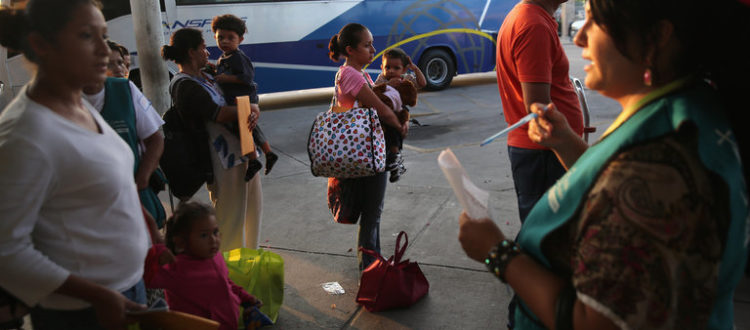Obama Administration Is Quietly Delaying Thousands of Deportation Cases
Published on October 7th, 2016
Central American immigrants who had been released from United States Border Patrol detention waited at the Greyhound bus station in McAllen, Tex., in July 2014. CreditJohn Moore/Getty Images
By Caitlin Dickerson
October 6, 2016
NewYork Times
The Obama administration is delaying deportation proceedings for recent immigrants in cities across the United States, allowing more than 56,000 of those who fled Central America since 2014 to remain in the country legally for several more years.
The shift, described in interviews with immigration lawyers, federal officials, and current and former judges, has been occurring without public attention for months. It amounts to an unannounced departure from the administration’s widely publicized pronouncements that cases tied to the so-called surge of 2014 would be rushed through the immigration courts in an effort to deter more Central Americans from entering the United States illegally.
The delayed cases are those of nearly half of the Central Americans who entered the United States as families since 2014, and close to a quarter of the total number of Central Americans who entered during that period, according to figures from the Justice Department.
The delays are being made as a cost-saving measure, federal officials said, because of a lapse in enforcement that allowed immigrants who were supposed to be enrolled in an electronic monitoring program to go free.
Some of those affected had failed to report to government offices to be fitted with GPS ankle bracelets, according to a February memo from the chief immigration judge, Print Maggard, in Arlington, Va.
Now that the government will not have to pay the daily fee of $4 to $8 a person to monitor such bracelets, the immigrants’ cases have been pushed back for years, some until 2023, judges and federal officials said. The cases of those who met their reporting obligations are still being expedited, with some cases moving faster than lawyers and judges had expected.
“The whole thing is docket chaos,” said Paul Schmidt, who retired in June after a 30-year career working for federal immigration agencies, the last 13 years as an immigration judge.
 A Honduran immigrant displayed an ankle bracelet, which had been attached by Immigration and Customs Enforcement, at an immigration reform rally in Newark in 2013. CreditJohn Moore/Getty Images
A Honduran immigrant displayed an ankle bracelet, which had been attached by Immigration and Customs Enforcement, at an immigration reform rally in Newark in 2013. CreditJohn Moore/Getty Images
It was not clear whether the immigrants’ failure to report was intentional or the result of unclear instructions. Deportations are carried out by two government agencies: the Department of Homeland Security, which arrests people charged with violating immigration laws, and the Executive Office for Immigration Review, a branch of the Justice Department that adjudicates deportations. It is common, lawyers and judges said, for immigrants who do not realize that the two agencies are distinct to betray their obligations out of confusion.
The Department of Homeland Security began using GPS ankle monitors in 2015 after determining that many recent immigrants were not appearing in court as required, said Sarah Rodriguez, a spokeswoman for Immigration and Customs Enforcement. Officials at the agency acknowledged that immigrants whose cases were being delayed might also fail to appear.
Along with the cases being postponed, other cases are being catapulted forward, sometimes by years, onto the dockets of judges who were recently hired to address the immigration system’s backlog of cases, which has reached record levels. Yet even this attempt to speed things along, lawyers say, could lead to more delays.
“In all of these cases, I’m going to go into the court date and say, ‘I was not given any chance to say whether or not I was available, so you have to adjourn this,’” said Bryan S. Johnson, a private immigration lawyer in New York.
Many immigrants whose cases will now move faster and who would have sought pro bono counsel may also have to go to court unrepresented.
“We can’t take on someone else who is on a waiting list because someone we thought was going to be completed is now still our case for four years,” said Eleni Wolfe-Roubatis, the immigration program director at the Centro Legal de la Raza in Oakland, Calif., a legal services agency for immigrants. She said dozens of her cases had been pushed to as late as 2020.
The immigrants affected by the delay are primarily families who entered the United States illegally since 2014, when record numbers of Central American migrants crossed the southern border, many seeking asylum status because of gang violence and lawlessness in their home countries.
Deportation proceedings for unaccompanied minors who entered the United States during that time are still being expedited.
But despite these deterrent efforts, the number of Central American families that will come into the country illegally this year is expected to exceed that of 2014, according to data from the Department of Homeland Security.





